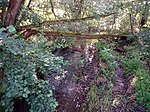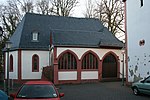Ronneburg Castle (German: Burg Ronneburg) is a castle in Ronneburg in the Main-Kinzig district of Hesse, Germany. It is a hilltop castle situated near the near Altwiedermus village on a steep basalt cone. Its position makes it visible from afar. It lends its name to the Ronneburg hill country.
Originally founded in the 13th century as a Mainz castle to secure the territory, Ronneburg Castle came under the ownership of the Ysenburgs in 1476. Its greatest significance was in the 16th century when it served as the residence of the Ysenburg-Büdingen-Ronneburg collateral line. The castle showcases Renaissance architecture, including the distinctive domed helmet of the keep, the Zinzendorf Building, and the New Bower. During the Thirty Years' War, the core castle was substantially damaged by fire, and a few years later, it was plundered. Subsequently, Ronneburg Castle lost its role as a fortress and noble seat, becoming a refuge for social fringe groups like the Moravian Brethren. Its status as a historical monument was acknowledged around 1900. The well-preserved medieval and early modern castle buildings have since made it a popular regional excursion destination










